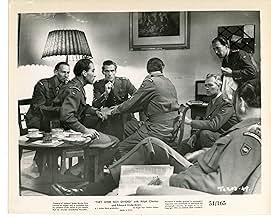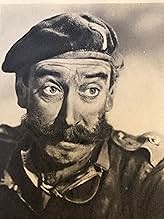NOTE IMDb
6,0/10
363
MA NOTE
Ajouter une intrigue dans votre langueThe story of men in the Guards Armoured Division in WWII, from basic training through to battle.The story of men in the Guards Armoured Division in WWII, from basic training through to battle.The story of men in the Guards Armoured Division in WWII, from basic training through to battle.
- Réalisation
- Scénario
- Casting principal
Rufus Cruickshank
- Sergeant Dean
- (as Rufus Cruikshank)
Avis à la une
This is an early work of Terence Young, the director, but a well-made, engrossing and ultimately very moving British war drama of World War II. Interestingly a very young Desmond Llewelyn has a cameo role as a Welsh tank commander, and when it came time for Young to find a new Q for the second James Bond movie, the original no longer being available, he remembered Llewelyn and cast him in what is now the longest running continuous role in the James Bond saga.
Starting 'today' with Princess Elizabeth riding behind her late father on Horse Guard's Parade, and then flashing back to 1941. Harry Waxman's atmospheric black & white photography facilitates the use of copious amounts of actuality footage (including both Montgomery & Eisenhower), rather at odds with Lambert Williamson's lush score.
Director Terence Young later hit the big time with the James Bond films; hence the reappearance in them of several of this film's supporting cast (including 'Q' himself).
Director Terence Young later hit the big time with the James Bond films; hence the reappearance in them of several of this film's supporting cast (including 'Q' himself).
This is quite an interesting drama-documentary that largely sets out to reinforce the inter-reliance of British and American forces during WWII. It follows the training and perilous escapades of an armoured regiment from the Brigade of Guards as they take their tanks into the low countries towards the end of the war. It cleverly interweaves actuality footage with the dramatised action delivering superbly shot scenes married with some more intimate assessments of the characters we are following. The actors themselves are far less important to the overall message - the two principals being the American Ralph Clanton ("Morgan") and Edward Underdown ("Hamilton") - they develop and come to represent the bond that binds the two armies, nations - with a message that what they have in common is not necessarily a tangible thing, but the higher purposes of freedom etc. There's a more substantial role for Michael Trubshawe ("Maj. Noble") equipped with a formidable moustache and the eagle-eyed amongst us might spot Desmond Llewellyn and Christopher Lee amongst the solid supporting effort. It's is a bit slow at times, and the dialogue pretty stilted - loads of stiff upper lip stuff - but overall, it's an informative, if at times, speculative glimpse into wartime attitudes and behaviour on the front line that is well worth watching.
I was hoping for a more compelling film; but there was far too much dialogue, and not enough action. Especially, after the basic training section of the film, which is actually the better part of the movie.
There were just too many bromides and cliches that were continually interfering with the natural evolution of the film. The actors did a competent job, as did the director, but the production values, to say the least, were slipshod. Maybe it was because it was an armored division. Armored division films of WW all seem to suffer from similar shortcomings; with the exception of Patton. Films like The Battle of the Bulge, The Battle of Alamein, Desert Fox, Rommel, and even the modern Fury with Brad Pitt, all had character development problems, action sequence problems, and pacing problems.
Doing dialogue for these types of films is very difficult to accomplish; that is why very few of them are highly praised compared to infantry, naval, and air force films. The natural confining aspect of a tank does not lend itself to good development of dialogue. However, to be fair, the film is watchable and entertaining, and will satisfy most WW 2 genre fans.
There were just too many bromides and cliches that were continually interfering with the natural evolution of the film. The actors did a competent job, as did the director, but the production values, to say the least, were slipshod. Maybe it was because it was an armored division. Armored division films of WW all seem to suffer from similar shortcomings; with the exception of Patton. Films like The Battle of the Bulge, The Battle of Alamein, Desert Fox, Rommel, and even the modern Fury with Brad Pitt, all had character development problems, action sequence problems, and pacing problems.
Doing dialogue for these types of films is very difficult to accomplish; that is why very few of them are highly praised compared to infantry, naval, and air force films. The natural confining aspect of a tank does not lend itself to good development of dialogue. However, to be fair, the film is watchable and entertaining, and will satisfy most WW 2 genre fans.
THEY WERE NOT DIVIDED is a near-forgotten British WW2 movie, directed by none other than Terence Young, the man who would later helm DR NO and FROM Russia WITH LOVE amongst other well-remembered movies. By comparison, this is the kind of film that few people bother watching and even fewer remember these days. It doesn't help that the script is quite dry, the narrative fairly stodgy, and there's a distinct lack of big-name actors to give audiences a reason to watch. Instead, THEY WERE NOT DIVIDED goes for a low key, almost documentary-style approach as it follows new recruits as they join a Welsh Guards battalion, train, and eventually journey to France to see action in their tanks.
This kind of template is familiar from the modern-day likes of BAND OF BROTHERS but the execution is only so-so here. There's a lot of talk and back-and-forth dialogue, but when it comes to the action, the big set-pieces that everybody remembers are hurried through. Stock footage is also used quite liberally. I didn't mind the unknown lead actors, although the heavy-handed messages smack of propaganda (basically, America and Britain should work together as one) which is bizarre given that the war had been over for four years when this was shot.
Most of the fun comes from spotting future actors in support. Michael Brennan (LUST FOR A VAMPIRE) is particularly good fun as the enthusiastic Welsh soldier, and there's a cameo from real-life RSM Brittain, who adds some humour. Christopher Lee only has a couple of lines but is in the background in almost every scene in the film, while future Q Desmond Llewellyn plays a tank driver.
This kind of template is familiar from the modern-day likes of BAND OF BROTHERS but the execution is only so-so here. There's a lot of talk and back-and-forth dialogue, but when it comes to the action, the big set-pieces that everybody remembers are hurried through. Stock footage is also used quite liberally. I didn't mind the unknown lead actors, although the heavy-handed messages smack of propaganda (basically, America and Britain should work together as one) which is bizarre given that the war had been over for four years when this was shot.
Most of the fun comes from spotting future actors in support. Michael Brennan (LUST FOR A VAMPIRE) is particularly good fun as the enthusiastic Welsh soldier, and there's a cameo from real-life RSM Brittain, who adds some humour. Christopher Lee only has a couple of lines but is in the background in almost every scene in the film, while future Q Desmond Llewellyn plays a tank driver.
Le saviez-vous
- AnecdotesOne of the only movies, until Fury (2014) that used an authentic Tiger tank.
- GaffesAn on screen caption reads "1943 Anzio and the war being won in Italy". The Anzio landings actually took place in January 1944.
- ConnexionsReferenced in 30 Years of James Bond (1992)
- Bandes originalesThe British Grenadiers
(uncredited)
Traditional
Arranged by Jacob Kappey
Meilleurs choix
Connectez-vous pour évaluer et suivre la liste de favoris afin de recevoir des recommandations personnalisées
Détails
- Durée
- 1h 42min(102 min)
- Couleur
- Rapport de forme
- 1.37 : 1
Contribuer à cette page
Suggérer une modification ou ajouter du contenu manquant


























